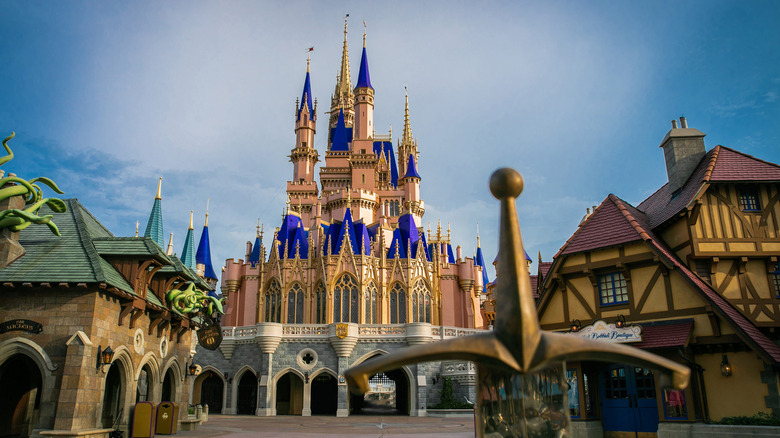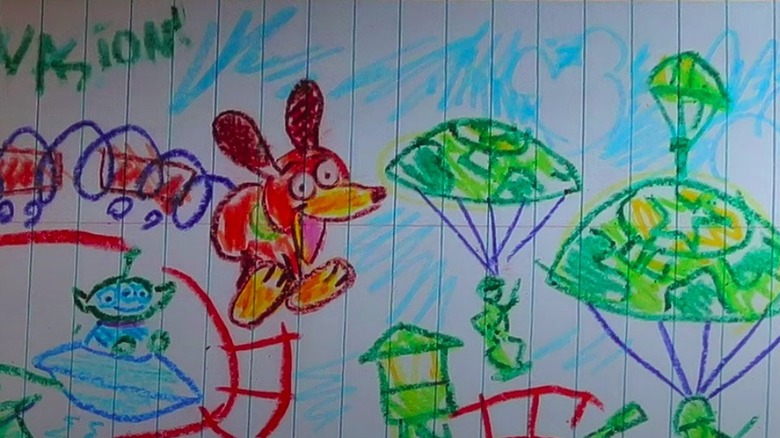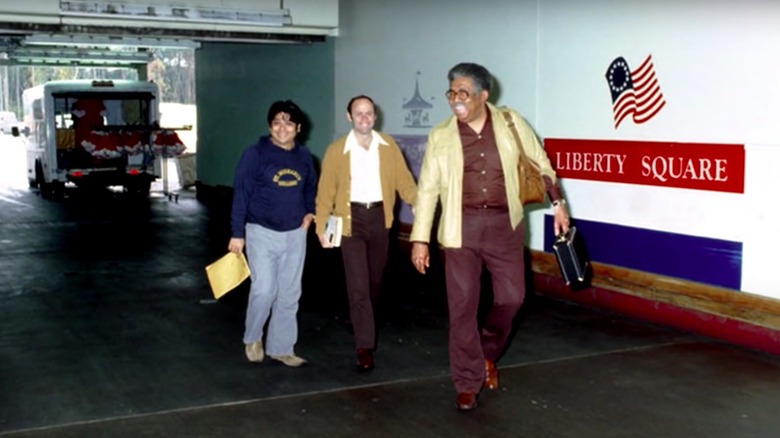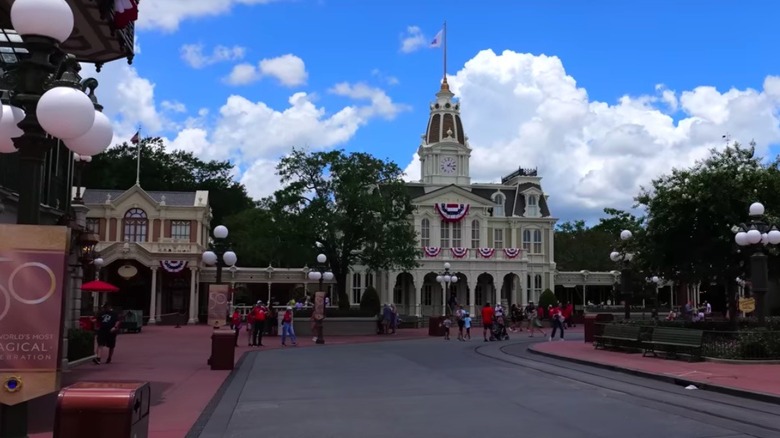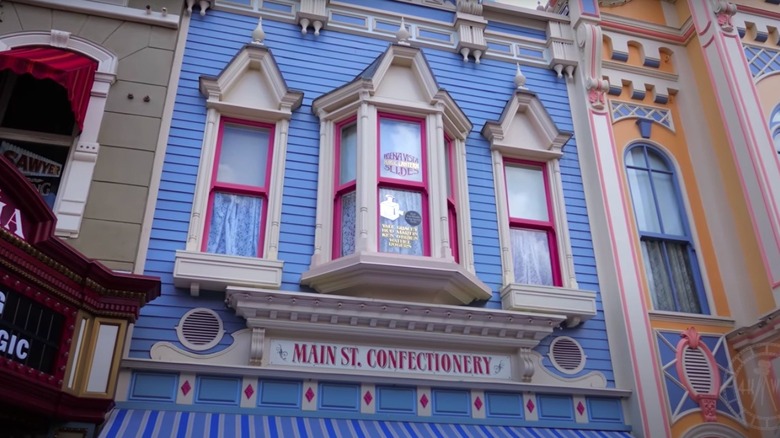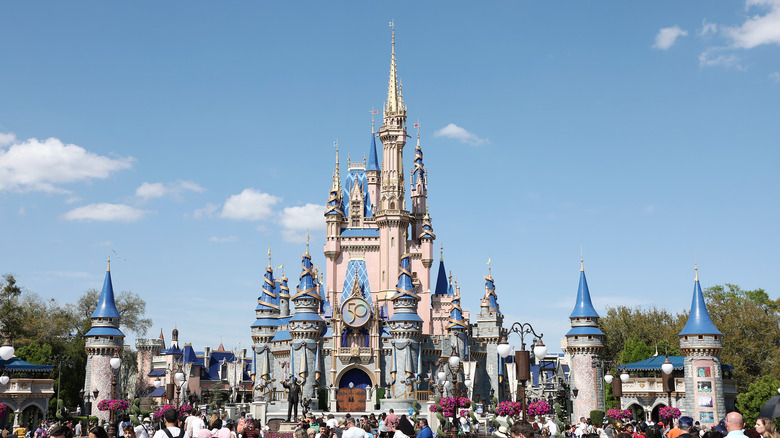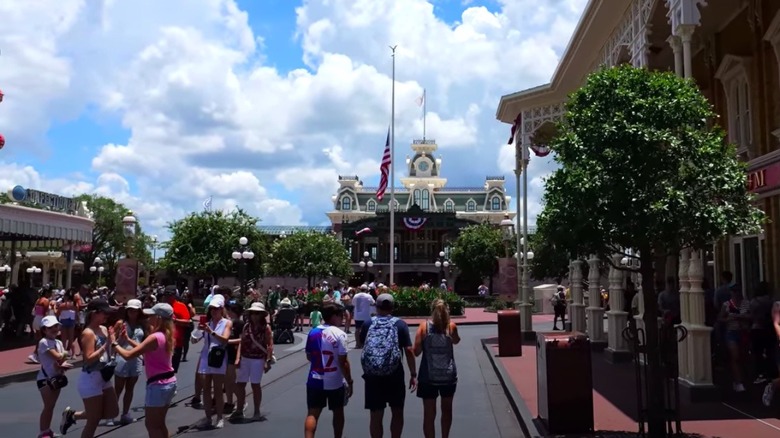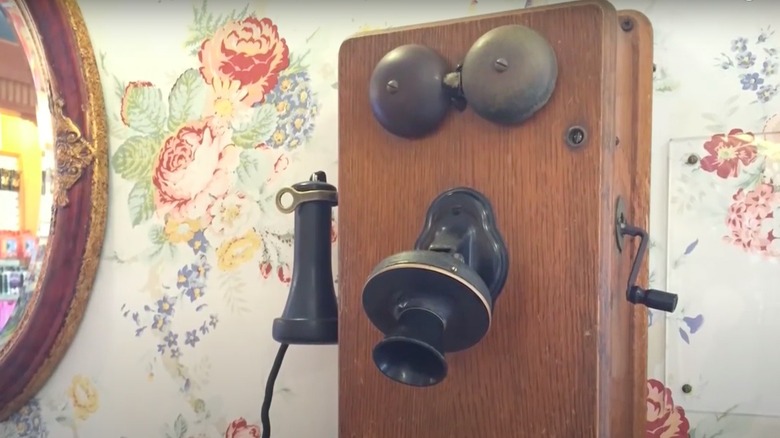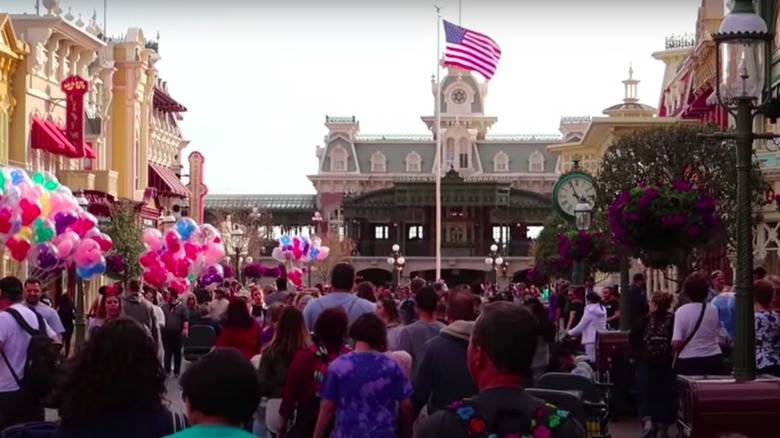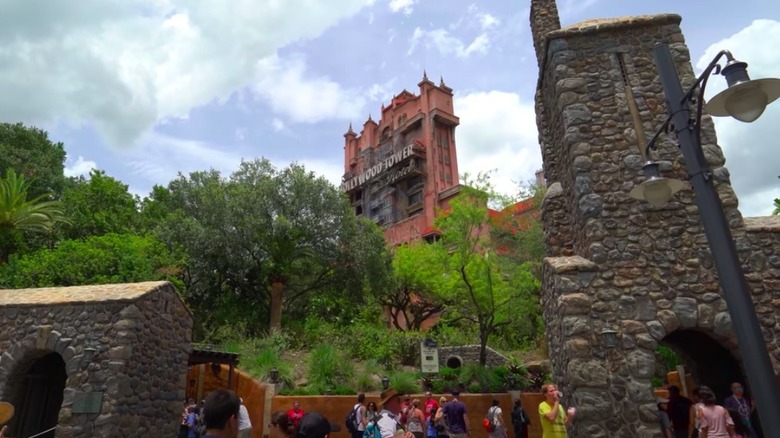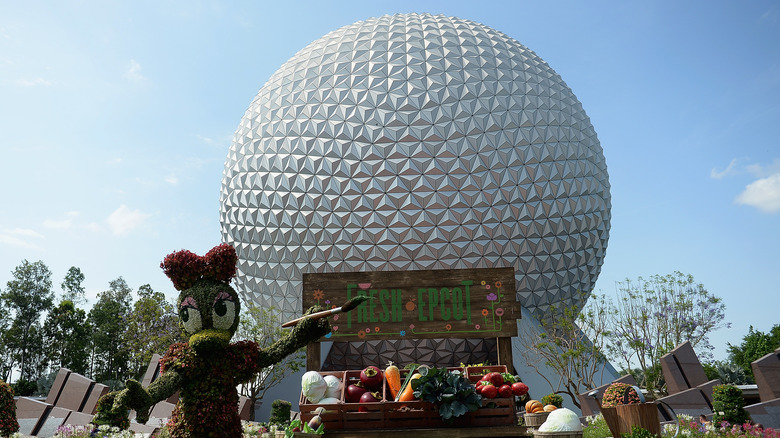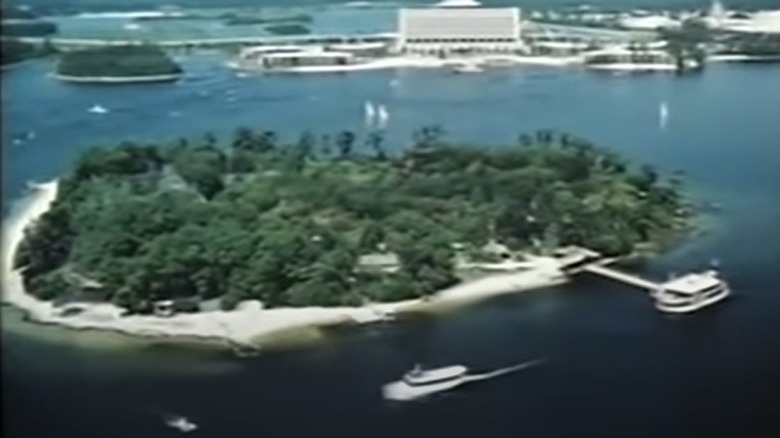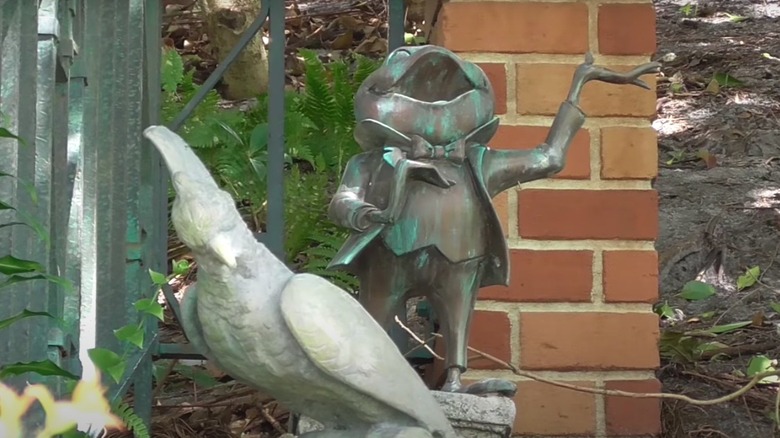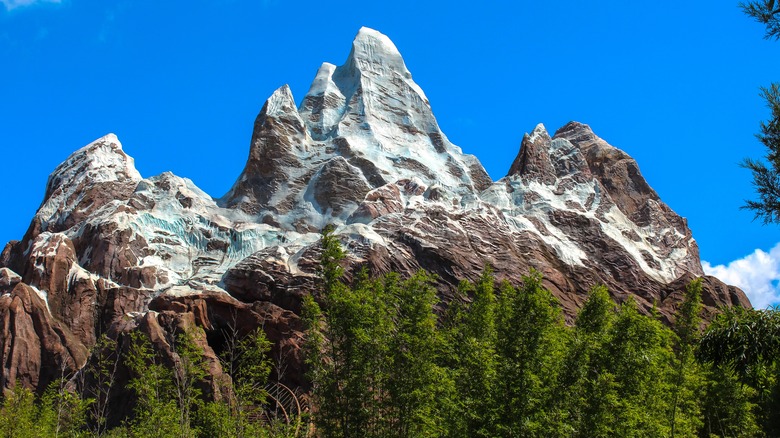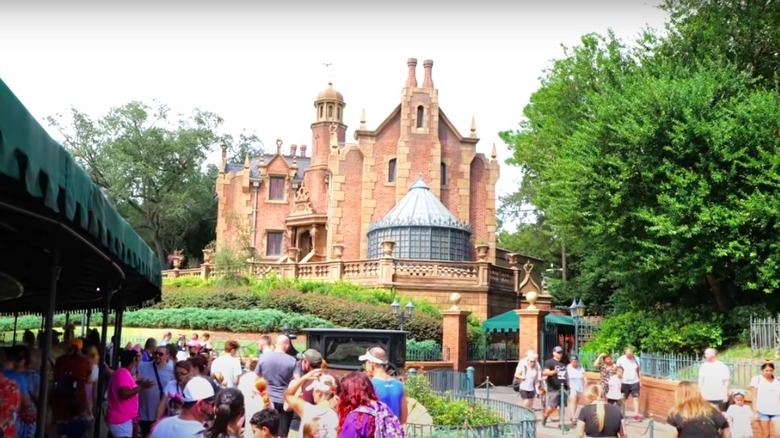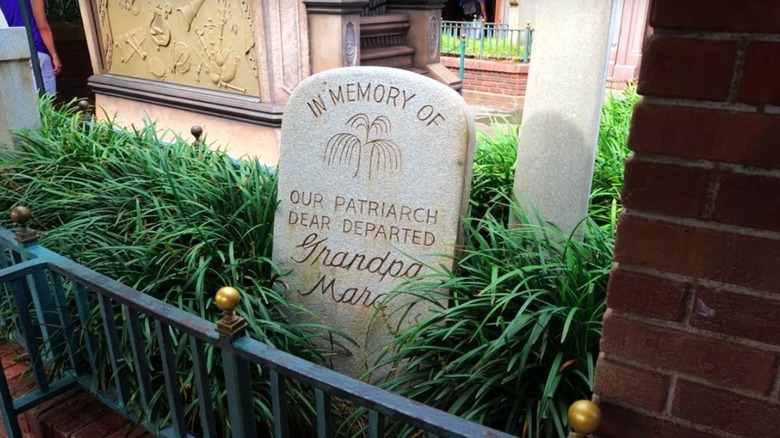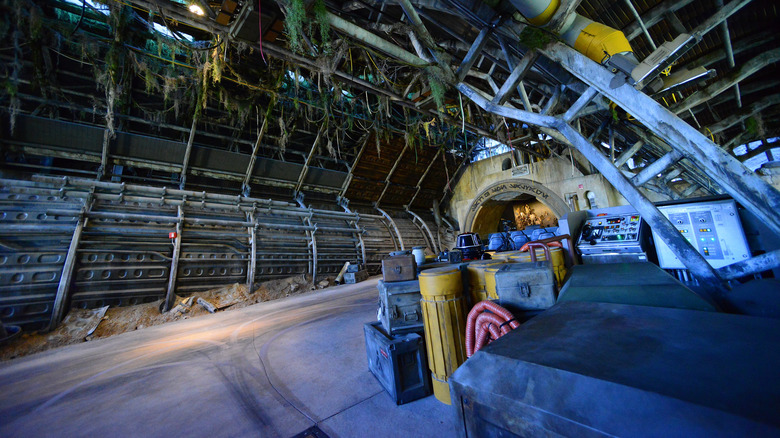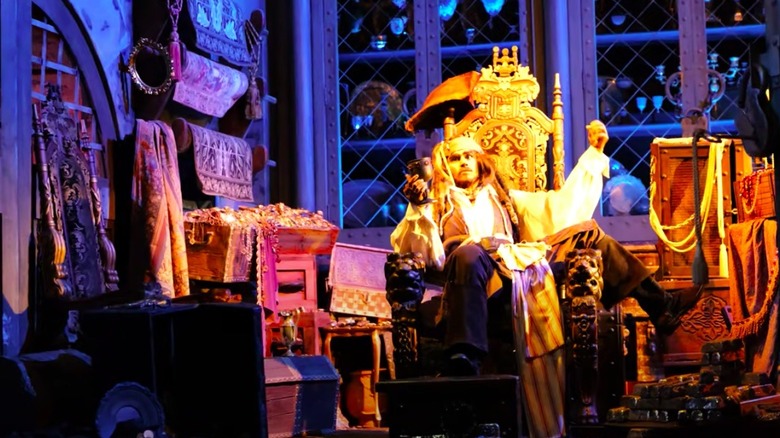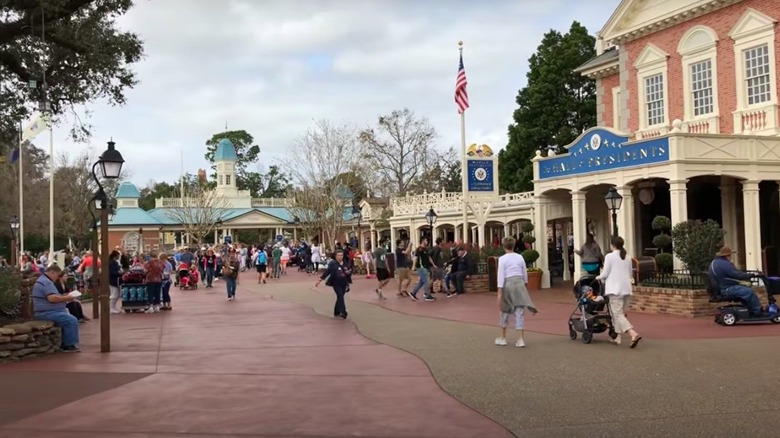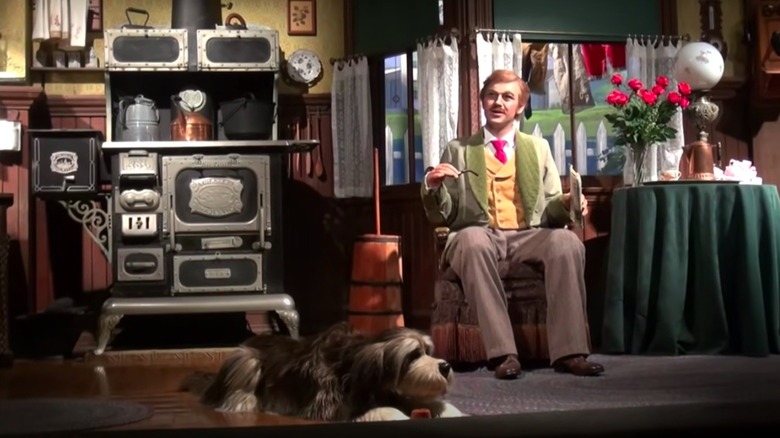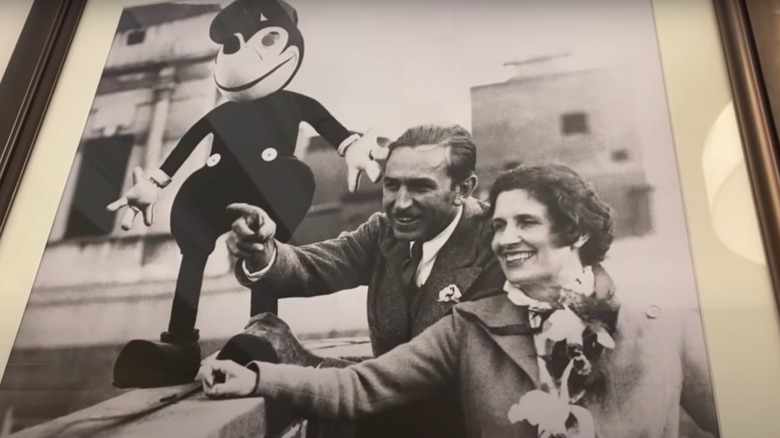Things You Might Have Missed On Your Last Trip To Walt Disney World
Walt Disney World is the premiere destination spot for thousands of families for a reason. More so than most amusement parks, each of Disney's parks is dedicated to entertaining every member of the family, from toddlers to elderly visitors. As a result, each Disney park comes equipped with an ample number of attractions designed for every respective visitor, regardless of if you're seeking a fast-paced roller coaster like Space Mountain or a meandering boat ride like Pirates of the Caribbean.
Of course, a key aspect that separates Disney from its competitors is its impressive attention to detail, each park containing dozens of references, homages, and small details that most visitors probably won't notice at first glance. However, each of these tiny details is integral in creating a one-of-a-kind magical experience for anyone and everyone who steps foot on Walt Disney World's property.
With how many of these details there are in Disney World, more than a few things might slip past even the most hardcore Disney fan who visits the Magic Kingdom or any of its adjoining sister parks. In some cases, these might be homages to influential Disney Parks' engineers (colloquially known as "Imagineers"). In other instances, it might be in-depth information about bygone Disney attractions that have long since shuttered their doors.
From secret passages beneath the Magic Kingdom to easily missed easter eggs, here are some little-known pieces of information you might not have known on your most recent trip to the Most Magical Place On Earth.
There are Hidden Mickeys throughout the park
You might not always notice them, but Disney was careful to include literally hundreds of hidden cameos from its most famous star — Mickey Mouse himself — in almost every one of their attractions. These camouflaged Mickeys (affectionately known as "hidden Mickeys") can be sighted all over Walt Disney World's parks, with Imagineers depicting them in areas that receive a ton of foot traffic crowds as well in the middle of most rides.
In most cases, hidden Mickeys fall into two categories. First, there are the far more obvious hidden Mickeys, usually seen in the background of rides or in other areas of the park (even the manhole covers on the street include these small hidden Mickeys). Far less noticeable are the dozens of other well-placed Mickeys that take a bit more time to notice. These Mickey figures require careful attention, and are sometimes only seen for a few moments. For instance, on EPCOT's flight simulator, Soarin', during the hot air balloon sequence of the ride, you'll briefly notice three balloons align to form the characteristic shape of Mickey's head. There's also hidden Mickey's in character's drawings near the rides.
It may take a sharp eye and dedication in order to find these hidden Mickeys during your visit to Walt Disney World, but rest assured: there are dozens upon dozens of these hidden figures all over each park.
The secret passageways below Magic Kingdom
To build a better sense of immersion in each of their parks, the more minute operational aspects of Disney World are purposefully kept hidden from the public eye. For instance, as you walk around the park, you're not likely to see how Disney disposes of its trash or caters to delivery trucks. Furthermore, you're also guaranteed not to see a character that belongs to one section of the park pop up in another area.
Disney manages to accomplish this feat through a system of underground tunnels known as Utilidors. Spanning the entire Magic Kingdom, the Utilidors allow Disney employees to traverse beneath the park, getting from one area to another in a limited time without being seen by guests. In these tunnels, there are locations dedicated to trash disposal, costuming, and an offloading zone for trucks. Here, Disney cast members are free to change costumes, eat, and rehearse their roles.
According to Disney legend, the idea for a subterranean tunnel system originated when Walt Disney happened to see a cast member dressed as a cowboy walking through Disneyland's Tomorrowland. Feeling the cast member looked achingly out of place in the futuristic facade of Tomorrowland — spoiling the illusion of the entire area — Disney began laying out plans for an underground city beneath Magic Kingdom. Whether this story is true or not, the Utilidors have allowed Disney characters to access each land in Magic Kingdom since the park opened, preserving the immersive experience Disney worked so hard to create.
Disney's trademark Smellitzers
Have you ever walked through Disney World and caught yourself sniffing some delicious scents in the air? These might include such intoxicating smells as newly-popped popcorn, warm apple pie, or baked cookies straight out of the oven. You might find yourself looking around for the source of said smells, but in reality, these scents are artificially generated through an innovative Disney device known as a Smellitzer.
To understand what exactly a Smellitzer is, it helps to think of it almost as a large aroma diffuser. These devices are positioned in specific locations around Walt Disney World, periodically omitting a certain scent through a mixture of fans and pressurized air. Disney strategically places these Smellitzers in special locations, helping create a greater feeling of immersion for visitors as well as triggering a sense of nostalgia among guests. For instance, one might associate the smell of cookies with childhood, a feeling that Disney hopes to elicit from every visitor who steps through its gates.
Far from utilizing the scent of food alone, Disney also has a Smellitzer on some of its most popular rides. As an example, guests who ride on Pirates of the Caribbean might notice the smell of salt water and wood in certain scenes, while guests who set out on EPCOT's Soarin' are likely to smell jasmine, fresh earth, and coastal sea breezes. These all originate from a hidden Smellitzer somewhere on the attraction.
The Main Street area pays homage to valued Disney employees
As you might expect, there aren't many opportunities for Disney's Imagineers to sign their name onto the rides they helped design and construct for. Still, that's not to say that there aren't some subtle references to Disney's most treasured employees from decades past. In many instances, these might be small visual nods to Disney's Imagineers that most guests are likely to gloss over upon first glance. This can especially be seen on Main Street, U.S.A., through the numerous shop windows advertising fictional businesses in the area.
In most cases, many of the names you see on Main Street, U.S.A. are related to an actual person — usually, someone who had a hand in developing Disney's parks or who was immeasurably valuable to the company at some time or another. Humorously, many of the "businesses" attached to these persons also reference either their specific positions or their personal interests. For example, the name on the Walt Disney World Railroad Office reads Walter Elias Disney, a clear reference to the company's founder that also acknowledges Disney's avid love of trains. Not far away, you'll find a window referencing the Dean of the Main Street College of Arts and Sciences, Martin Sklar, an homage to the artist and Imagineer instrumental in the construction of several Disney theme parks.
Other names featured on Main Street, U.S.A. are influential Imagineers X. Atencio, Marc Davis, Claude Coats, Mary Blair, Blaine Gibson, Yale Gracey, and Disney executive Card Walker, among others.
The secret suite in Cinderella Castle
One of the most breathtaking sights you'll see during your visit to Walt Disney World is bound to be Cinderella Castle at Magic Kingdom. Over one hundred feet taller than Sleeping Beauty Castle at Disneyland, it's a building that has the ability to leave both children and adults speechless on account of its sheer size, immaculate design, and pastel color scheme. For how large the castle is, you'd immediately think the building is filled with rooms guests can venture in, explore, and even spend the night in. Sadly, Cinderella Castle does not have any standard rooms for guests to stay in — although there is one very exclusive suite located inside.
High up in the castle is a room known as the Cinderella Castle Suite, a scenic and carefully-designed room meant to emulate the palace residence of the famous Disney princess. As with the castle's exterior, the room is decorated with vibrant colors, as well as an assortment of unique amenities like a massive bathtub, a spacious parlor room, and a mirror that can be turned into a TV screen. Along with these one-of-a-kind features, the room contains numerous trinkets and items related to the story of Cinderella, including a glass slipper, a crown and scepter, and a collection of original Disney artwork.
In its earliest planning stages, this room was originally meant to house Walt Disney and his family whenever they visited the park. Nowadays, it's strictly offered to weekly contest winners, or special guests personally invited to stay at the suite.
You can find trash cans every 30 feet inside the park
If there's one thing above all else Disney focuses on, it's balancing a sense of wonder and magic, transporting each Disney World visitor to a place filled with imagination, fantasy, and childhood nostalgia. To create a picturesque environment that achieves this feeling, Disney dedicates themselves to removing any real-world inconveniences that might crop up in other amusement parks — namely, the issue of litter and garbage.
To promote a sense of cleanliness in the parks and to ensure guests always have a place to throw out their garbage, every park in Walt Disney World has well over 100 trash bins evenly spaced throughout the park. In fact, Disney is so entirely focused on garbage disposal, they distanced each trash can 30 feet apart from each other, meaning that — no matter where you are inside the park — a trash can is within easy walking distance.
Even if a guest chose to chuck their trash on the ground instead of in a bin, every Disney employee is taught to quickly pick up said trash and dispose of it immediately. This passionate dedication to keeping the parks clean is in direct accordance with Walt Disney's own wishes. As Walt personally vowed when designing Disneyland, "We're going to make it so clean that people are going to be embarrassed to throw anything on the ground."
Some phones in Magic Kingdom have a secret conversation
As is the case with its chief rival, Universal Studios Orlando, some of the phones you'll find randomly around Walt Disney World can actually be interacted with. In most cases, all you need to do is pick up the phone, press it to your ear, and you'll be entreated to a fun pre-recorded message that'll add a little extra whimsy to your day.
The first of these phones can be found upon your entrance to the Magic Kingdom. On Main Street, U.S.A., inside the hat shop known as The Chapeau, you'll notice an old-fashioned phone hanging on the wall. While it may look like a simple prop meant to tie-in into the store's homely early 20th century aesthetic, if you actually pick up the phone, you'll overhear some juicy town gossip from some old-timey town residents. This phone and its related conversation were originally found at Magic Kingdom's Market Hous, eventually finding its way to The Chapeau after the Market House was permanently closed.
Heading into Tomorrowland, you can spot another interactive phone — this one far more futuristic-looking than The Chapeau's — near the Tomorrowland Transit Authority PeopleMover. To listen in on a pre-recorded message, you'll need to type in a specific phone number, with the subsequent call being made to an array of colorful sci-fi characters, like Johnny Jupiter, Omega 5277, Colena Lunar, and a restaurant called Earth's Crust Pizza.
The American flags in Disney aren't really flags
In striving to recreate a historical setting reminiscent of his small-town upbringing in Marceline, Missouri, Walt Disney introduced an array of American flags that can be found all over Disneyland. The same thing can be said for Disney's later theme parks in Florida, particularly in regard to such locations as Main Street, U.S.A. If you stop and look at any one of the dozens of flags dangling above Walt Disney World's parks, though, you might notice that the flag has a few noticeable discrepancies.
Most notably, every American flag within Walt Disney World is missing a few stripes and more than a few stars. While this might seem like a glaring oversight on Disney's part, each flag was intentionally designed this way for a very specific reason. As Disney would have to follow the traditional customs for raising and lowering each flag inside their parks, meaning that they don't have to be taken down in severe weather or have a light shone on them at night (per the U.S. Flag Code), the company opted to use a prop flag instead, making it appear as though they were actual flags upon initial view. However, the flag ceremoniously lowered at the end of each day on Main Street is indeed a real flag, hence why it's taken down at the end of the day (per the Flag Code).
Disney used a special strategy to keep you continuously moving
You might not always notice it, but Disney meticulously tracks how many people venture inside their parks. From tallying how many people enter through the entrance gates to noticing which parts of their parks receive the most foot traffic, Disney has proven itself incredibly skilled at continuously ushering people forward. As great as the park is at handling crowds today, Walt Disney himself implemented a specific strategy to prevent certain areas of Disneyland from clogging up — a foolproof tactic that eventually found its way to Walt Disney World.
When mapping out Disneyland, Disney introduced a visual trick that would have people always moving forward. Noticing that his pet dog would follow him around the house whenever he had a hot dog in hand, Disney used a similar strategy in the planning stages of Disneyland. Referred to as "weenies," Disney strategically placed large objects in the background of certain areas that park visitors would instantly notice and gravitate toward (in the case of Disneyland, this object would be Sleeping Beauty's Castle at the end of Main Street, U.S.A.)
Walt's "weenie" strategy proved successful enough that, when it came time to plan Magic Kingdom, the developers similarly planted a large-scale object in the center of the park (Cinderella's Castle). This "weenie" strategy was later implemented at future Disney parks like EPCOT (with Spaceship Earth), Animal Kingdom (the Tree of Life), and Hollywood Studios (The Twilight Zone Tower of Terror).
EPCOT was originally meant to be its own live-in community
Opening its doors in 1982, EPCOT has the distinction of being the first main theme park addition to Walt Disney World after Magic Kingdom's debut eleven years earlier. A celebration of world cultures, it's undergone several interesting changes over the years, from focusing on environmentalism and conservation to innovative technology and alternative energy sources. Yet for as much as it's changed, the original iteration of EPCOT called for a dramatically different concept the likes of which the world had never before seen.
Initially, Walt Disney's hope for EPCOT was to create an experimental community that people could actually live in. In developing the concept for this proto-utopian city, Disney arranged to create a model community of the future, filled with state-of-the-art technologies and conveniences residents could sustainably live off of and continuously improve upon over time. Dubbing this city the Experimental Prototype Community of Tomorrow (or E.P.C.O.T., for short), Disney had hoped for 20,000 people to move into the community by the late 1960s.
Disney's death in 1966 forever quashed the company's ambitious plans for this version of EPCOT. Without Walt's enthusiasm steering the project's direction, the feasibility of the idea became less and less likely as time drew on. By the 1970s, as Disney looked to construct new parks inside Disney World, the company eventually repurposed the park, retooling it into the international showcase-driven theme park it is today.
The tropical paradise of Discovery Island
EPCOT may have been the first theme park aside from Magic Kingdom to be added to Walt Disney World, but it wasn't the first major location offered inside Disney's property. Three years after Magic Kingdom first opened to the public in 1971, the company debuted a separate area on Bay Lake that guests could travel to known as Treasure Island.
Located within sight of the Contemporary Resort, Treasure Island was an 11.5-acre island attraction that operated as a nature and animal observatory for 25 years. Eventually renamed Discovery Island, the island boasted numerous exotic wildlife species, ranging from lemurs and Capuchin monkeys to cranes and toucans (interestingly, they contained the last known dusky seaside sparrow before the species was declared extinct in 1990).
After years of financial struggles, Disney eventually chose to close Discovery Island, shutting off access to the island in 1999. Since then, the island's buildings have slowly deteriorated from neglect and inclement weather. Disney has a strict policy prohibiting people from entering the island, although a few people have led unsanctioned visits to the islands over the years. Most recently, in 2020, a man illegally camped on the island, describing the area as a "tropical paradise." When he was apprehended by local authorities, he was removed from the island and banned from stepping foot on Disney property ever again.
A few nods to the departed Mr. Toad
When the Magic Kingdom first opened in 1971, it contained numerous rides taken straight from Disney's original location in Anaheim. One of these attractions was Mr. Toad's Wild Ride, a dark ride that takes passengers on a loose retelling of "The Adventures of Ichabod and Mr. Toad," embarking on a rip-roaring adventure with the titular amphibian in early 20th century England. For over 20 years, Mr. Toad's Wild Ride remained a staple of Magic Kingdom's Fantasyland. In 1998, though, the attraction was slated for removal and was soon replaced by The Many Adventures of Winnie the Pooh in 1999.
While guests might lament the loss of Mr. Toad's Wild Ride, Disney was careful to include a few nods to the departing J. Thaddeus Toad in their new attraction. Early on in The Many Adventures of Winnie the Pooh, as you pass into Owl's house, you can find a portrait of Mr. Toad handing the deed of Toad Hall to Owl, symbolically passing the torch from the former Disney world attraction to its successor. In the same room, you can also spot a painting of Pooh together with Moley, one of Mr. Toad's best friends from the original Disney film.
Another homage to Mr. Toad can be found outside of the Haunted Mansion. In the outdoor pet cemetery section of the graveyard, you might notice an out-of-place statue of Mr. Toad amidst all the tombstones and burial markers of the deceased animal companions.
The Disco Yeti of Expedition Everest
One of the premiere attractions of Disney's Animal Kingdom is Expedition Everest, a high-speed roller coaster that takes guests on an unforgettable journey through the heart of the Himalayan Mountains. A key feature on the ride — aside from its exciting forwards and backward acceleration — is that it allows guests to come face to face with the nefarious Yeti, a legendary creature said to dwell somewhere within the mountain.
At the time the ride was opened in 2006, Expedition Everest had one of the world's complex audio-animatronic figures in the form of the Yeti. Standing 25 feet tall and capable of moving five feet horizontally and a foot and a half vertically, the Yeti menaced riders near the very end of the attraction as they passed by. Unfortunately, shortly after the ride's official launch, the Yeti's framing split, putting the entire attraction in serious danger if the Yeti was operated its usual manner.
Theories abound as to why Disney hasn't set out to fix the issue, but since the Yeti ceased its normal operational movements, Imagineers have relied on an alternate way to present the Yeti. Instead of operating the Yeti with its regular movements, the attraction's designers added flashing strobe lights and a fan meant to tousle the Yeti's fur, creating an illusion of movement as riders pass by. Because of this effect, the Yeti has earned the unfortunate nickname, "Disco Yeti," amongst Disney World's visitors.
The Haunted Mansion's architecture reflects its park location
As similar as the actual ride is to its counterpart in Disneyland, the Magic Kingdom version of the Haunted Mansion contains a handful of differences to its original iteration. Most obviously, the architectural design of Florida's Haunted Mansion is drastically different from Disneyland's version. It may seem like a strange thing to change when bringing the ride over to Orlando, but the overhaul in architecture was made for a very important reason.
In mapping out where each attraction was to be located within the Magic Kingdom, the Imagineers had a slight problem trying to figure out where to place the Haunted Mansion, thanks in large part due to the ride's unique, horror-centric atmosphere. With the park's developers planning on building a Liberty Square in Florida in lieu of Disneyland's New Orleans Square, the Imagineers decided to place the ride there, aligning its general facade and exterior presentation to the area's theme.
As a result, the architectural layout for the Haunted Mansion was changed, the Imagineers favoring a mix between Hudson River Valley and Dutch Gothic style inspired by the Colonial buildings of 18th century America. This was meant to tie in to the historical authenticity of Liberty Square, helping the Haunted Mansion blend in with the overall layout of the area. It's for this reason that the Magic Kingdom's Haunted Mansion's exterior looks drastically different to the Greek Revival architecture of Disneyland's Haunted Mansion (itself meant to reflect its New Orleans Square setting).
All of the tombstones in the Haunted Mansion's graveyard reference the ride's creators
While on the subject of the Haunted Mansion, another staple many fans associate with the attraction has to do with its inventive queue, which sees guests travel through an eerie graveyard filled with memorably-named headstones. In many cases, these headstones contain humorous and darkly comic puns alluding to how the deceased met their end. Interestingly, much like the numerous shop windows on Main Street, U.S.A., many of these epitaphs pay homage to individuals associated with the Haunted Mansion's creation.
Some key names you'll find inside this cemetery include influential Disney personnel like Bill Martin (one of the original designers for Disneyland), as well as Imagineers and designers directly responsible for the Haunted Mansion's development, like "Grim Grinning Ghosts"' composer X. Atencio, artist Marc Davis, and effects supervisors Rolly Crump and Yale Gracey, to name just a few.
Other standout tombstones you'll find in the graveyard include an homage to Leota Tombs, a model designer employed at Disney who served as the visual inspiration for Madame Leota in the Haunted Mansion (fittingly, the face emboldened on her headstone sporadically opens its eyes and peers around). Visitors can also find a headstone referencing Paul Frees, the voice of the famous Ghost Host on the ride. If that weren't enough, you might also spot the name "Ravenscroft" carved into the interactive organ while waiting in line — a small nod to Thurl Ravenscroft, whose voice can be heard in several Disney attractions, including the Haunted Mansion.
Disney's sidewalks contain some subtle easter eggs
Disney never misses an opportunity to add some minor details to their attractions that puts guests one step closer to total immersion. For instance, several sidewalks in and around Disney World feature some incredibly small details that most people aren't likely to notice, but that illustrates Disney's meticulous attention to detail. In Fantasyland near the Storybook Circus, you might find a few peanut shells pressed into the cement pavement here and there (a reference to "Dumbo" and a detail that ties into the attraction's circus facade). Waiting in line for Journey of the Little Mermaid, you're also sure to find a few seashells dotting the ground beneath you.
Near Adventurleand's Zanzibar Trading Company, you'll see various pieces of treasure shining through the pavement. In the waiting room outside of the Country Bear Jamboree, you'll notice scratch marks on the ground from a bear's claws. As you disembark from your boat on Pirates of the Caribbean, you can spot some unique footprints belonging to a peg-legged pirate on the off-loading zone of the attraction. These tracks are meant to imply Davy Jones or Captain Barbossa from "Pirates of the Caribbean" waded through this area at some time or another.
Perhaps most striking are the unmistakable tracks of an Astromech droid that wind through Star Wars: Galaxy's Edge in Disney's Hollywood Studios. Working closely with Lucasfilm, Disney's Imagineers used molds of the original 1977 R2-D2 wheels for the tracks in Galaxy's Edge, deepening the connection between "Star Wars" and its theme park counterpart.
The chess players in Pirates of the Caribbean
As you wind your way through the Spanish Colonial castle that houses Pirates of the Caribbean, you might happen to see a pair of skeletal pirates focusing intently on a game of chess. This scene can be spotted in one of the two main queues for the ride, and like most of the scenes within the Pirates of the Caribbean attraction, it was actually meticulously thought out by the park's Imagineers.
As an avid fan of chess, the ride's designer, Marc Davis, vigorously researched chess positions that ended in a stalemate, using that for inspiration in Pirates of the Caribbean. If you look closely at the board the pirates are playing, you'll notice that any move essentially guarantees a draw. By establishing the pieces in such a formation, Davis comically hinted that the pirates died pondering their next move, the two of them stuck in a forever unwinnable game. Knowing that the board pieces might eventually move, Davis even taped the layout of the game underneath the board the buccaneers are playing on for future reference.
Further proof of Davis's love for chess can also be found in a blink-and-you'll-miss-it moment in the final scene of the ride. As Jack Sparrow leans back in his chair, basking in his newfound fortune, a shield above him brandishes the name Marco Daviso, with the crest containing two chess rooks in the upper right and lower left hand corners.
Liberty Square doesn't have any bathrooms for a reason
If there's one thing you've probably picked up by now, it's that Disney strives for a sense of complete immersion in every one of its parks. Whether it's planting droid tracks on the ground of Star Wars: Galaxy's Edge or recording the conversations you overhear on The Chapeau's phone, Disney is known for going the extra mile in creating a unique park-going experience. The same can be said for Magic Kingdom's Liberty Square, which contains an admittedly odd nod to historical authenticity.
To reflect the historical time period of its setting, Liberty Square is one of the few areas inside Walt Disney World not to contain a public bathroom, as 18th-century America obviously did not have public restrooms at this time. The only two places you can find a bathroom in the area are inside the Liberty Tree Tavern and the Columbia Harbor House. However, these bathrooms are located so far back inside the respective restaurants that they are actually inside adjacent park areas, meaning that they technically aren't even in Liberty Square.
In another impressive (and disgusting) nod to its historical time period, Disney's Imagineers added a brown pathway that runs throughout Liberty Square. This brown path is meant to simulate human waste, given that, historically, 18th-century Americans simply emptied the contents of their chamber pots into the street. It's a gross little detail, but one that, again, emphasizes Disney's attention to real-world accuracy.
Famous voices
Many rides have been added to Walt Disney World over the years, but it's important to remember that many of the park's most famous attraction were taken straight from Disneyland. It's for this reason that many of the attractions share some common features, including the use of some famous voice actors.
The most widely-repeated voice you're likely to make out is that of Thurl Ravenscroft, best known as the original voice for Tony the Tiger and his baritone rendition of the holiday classic, "You're a Mean One, Mr. Grinch." Ravenscroft's deep voice can be heard on several attractions throughout Magic Kingdom. In Pirates of the Caribbean, he's one of the many pirates singing "Yo Ho (A Pirate's Life for Me)," as well as appearing as Fritz in Walt Disney's Enchanted Tiki Room, Buff in the Country Bear Jamboree, and one of the singing busts in the Haunted Mansion.
The voices of several notable actors can also be overheard in Walt Disney's Carousel of Progress. Rex Allen, who acted as the original voice of John (the ride's main character) at the 1964 New York World's Fair, lent his voice for the role of the elderly grandfather. John's current voice actor is Jean Shepherd, the narrator of the famous holiday film, "A Christmas Story." Most noticeably, the ride also features a small vocal cameo from animation legend Mel Blanc in the role of Uncle Orville. In the past, Blanc made a career out of voicing several iconic Looney Tunes characters, such as Bugs Bunny, Daffy Duck, and Porky Pig.
Disney employees are instructed never to point or say I don't know
It takes a lot of work to become an employee in Walt Disney World, with every worker responsible for learning a series of skills that they're expected to one day use inside the parks. One strange thing every Disney employee is expected to remember is that, above all else, they're meant to never point or respond with "I don't know" to any question posed by a Disney World visitor.
Since it's believed that pointing with one finger may be misconstrued as a rude gesture in certain cultures, Disney employees are taught to point using two fingers. That's why, whenever you ask a park employee directions, you'll notice them point with their index and middle finger. According to Disney legend, this gesture may also be referencing a distinct characteristic of Walt Disney's. Throughout his life, Disney was a habitual cigarette smoker, although the company digitally altered any images of Disney smoking or holding a cigarette (resulting in the strange two finger gesture seen in many photos of Disney today).
Similarly, Disney employees are always meant to provide an answer to a guest's question, and to never respond with "I don't know." If the employee is unsure of how to answer a visitor's question, they'll either research the answer on their own or ask a fellow employee, but under no circumstances will they leave the guest without a definitive answer to their question.
